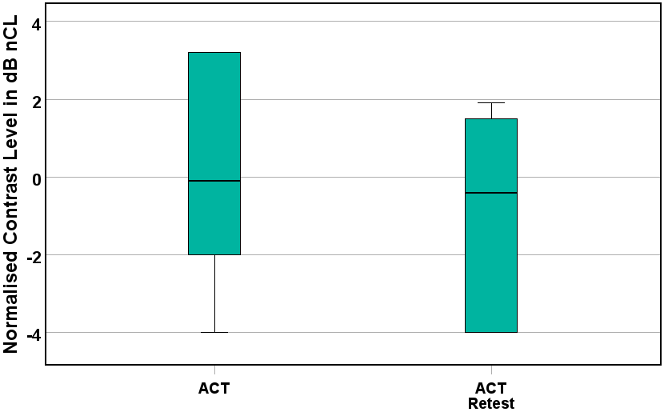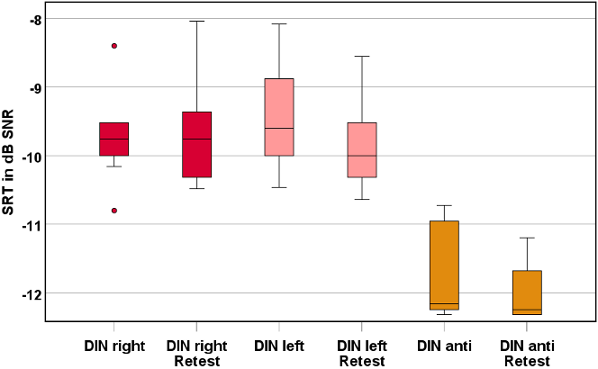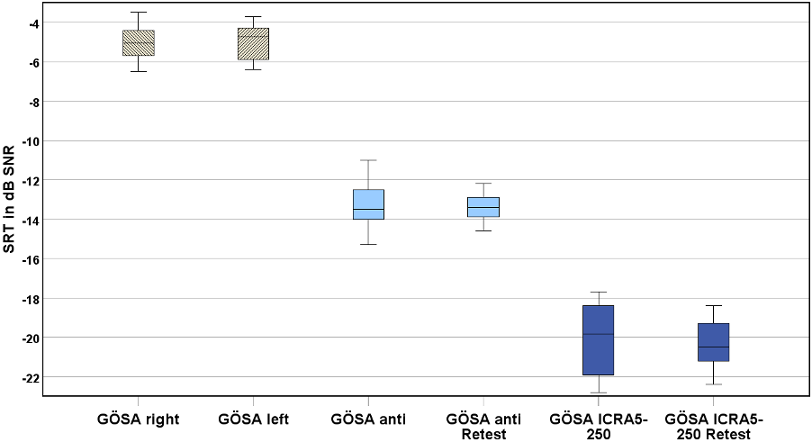[Pilot measurements for a population-based study to assess hearing status]
Sophie Jäker 1Petra von Gablenz 1,2
Inga Holube 1,2
1 Institute of Hearing Technology and Audiology, Jade University of Applied Sciences, Oldenburg, Germany
2 Cluster of Excellence Hearing4All, Oldenburg, Germany
Abstract
Surveys are crucial for obtaining precise information about hearing abilities in the general population. Building on the HÖRSTAT study (von Gablenz et al. 2015), which was conducted in 2010–2012 in northwest Germany, another large hearing study with adults is being planned. This study aims to combine established test procedures with promising yet less used procedures to provide a more accurate description of hearing abilities more representative of everyday life. The feasibility of the study program was tested in a pilot study with 10 young people, aged between 18 and 25 years, and with normal hearing.
The measurements of the pilot study included a determination of the pure-tone hearing thresholds for air conduction in the clinical frequency range (250 Hz–8 kHz) and in the high-frequency range (9–12.5 kHz) as well as for bone conduction (0.5–4 kHz). As a screening test, the digits-in-noise test (DIN) (van den Borre et al. 2021) was performed both side-separated and antiphasically. For the measurements of speech recognition, the Göttingen sentence test (Kollmeier et al. 1997) was carried out with monaural presentation in stationary noise, binaural-antiphasic in stationary noise, and binaural-diotic in fluctuating noise. In addition, a test for spectro-temporal modulation was added. Two cognitive tests were used to assess processing speed and crystallized intelligence. Furthermore, a standardized interview questionnaire with questions on sociodemographics, hearing health and noise exposure as well as a questionnaire on hearing in everyday situations was used. This contribution presents the results of the pilot study.
Keywords
epidemiology, prevalence, speech recognition
1 Introduction
Epidemiological studies on the hearing status of adults are useful in various ways. They enable an assessment of the need for care and its future development, allow age- and gender-specific reference values to be determined from socially mixed populations and can serve as a basis for normative regulations. The population-based study HÖRSTAT [1], conducted in 2010–2012, contributed to all of these areas. The study “Alltagsrelevante Merkmale des Hörstatus Erwachsener (Features of adults’ hearing status relevant in everyday life)” (ALLSTAT) builds on HÖRSTAT with an extended and audiologically in-depth examination program. This contribution presents the study program and selected results of the ALLSTAT pilot study.
2 ALLSTAT project
The aim of ALLSTAT is to collect data of 2,000 adults with regard to their hearing status. Participants from HÖRSTAT will be invited again and new participants will be recruited from stratified random samples of north-western German cities. The study program has interfaces with other epidemiological studies conducted in Germany, in particular the National Cohort (NAKO, [2]).
3 Methods
3.1 Participants in the pilot study
Ten participants (five female, five male) aged 18 to 25 years (average age: 23.6 years) took part in the ALLSTAT pilot study. All participants had normal hearing according to ISO 8253-3:2022, i.e., their hearing threshold levels at the frequencies 250 Hz to 8 kHz were generally not allowed to exceed 10 dB HL. However, there was a limitation for no more than two frequencies, where the hearing threshold level could be as high as 15 dB HL. The pure-tone average at 500 Hz, 1, 2, and 4 kHz was 0.1 dB HL in the right ear and –1.3 dB HL in the left ear. The participants had very little to no experience with speech tests, and German was their native language.
3.2 Study program
The study program combines clinical test procedures with established experimental procedures. It includes a questionnaire, an interview, cognitive test procedures, measurements in everyday life (subgroup), pure-tone audiometry also in the high-frequency range and a broad spectrum of speech-audiometric test procedures compared to other epidemiological studies, which enables an assessment of temporal resolution and binaural hearing. The examinations and measurements are as follows:
- Otoscopy
- Surveys:
- Standardized interview on sociodemographics, health status with ear diseases, noise exposure, etc.
- German short version of the Speech, Spatial, and Qualities of Hearing Scale (SSQ17, [3]) supplemented by items from the full questionnaire to complete the English-language short version (SSQ12, [4])
- Pure-tone audiometry:
- Hearing threshold levels for air conduction in the clinical frequency range (0.25–8 kHz) and in the high-frequency range (9–12.5 kHz)
- Hearing threshold levels for bone conduction (0.5–4 kHz)
- Speech audiometry with the Göttingen sentence test (GÖSA, [5]) with 20 sentences/list in different conditions:
- Monaural measurements of the left and right ear in stationary noise
- Binaural-antiphasic measurement in stationary noise (SπN0)
- Binaural-diotic measurement in fluctuating noise (ICRA5-250 [6])
- Speech audiometry with the Digits-in-Noise test (DIN, [7]):
- Monaural measurements of the left and right ear in stationary noise
- Binaural-antiphasic measurement in stationary noise (SπN0)
- Audible Contrast Threshold (ACT, [8]) for determining the detection threshold for spectro-temporal modulations
- Cognitive test procedures:
- Multiple choice vocabulary intelligence test (Mehrfachwahl-Wortschatz-Intelligenztest, MWT-B, [9]) as an indicator of crystallized intelligence
- Trail making test (TMT-A/B, [10]) to measure the processing speed
- Retest for one test method (random selection)
The ACT is a new test that brings experimentally used detection methods for spectro-temporal modulations into clinical application. Studies suggest that the ACT measurement result provides a good prediction of speech recognition in noise, in particular of the speech recognition when using hearing aids [8]. The procedure is similar to the conventional method for pure-tone audiometry. A sequence of short, non-modulated noise segments are presented, into which modulated noise is inserted as a target signal, triggered by the examiner. The degree of modulation is varied in the course of the measurement, thus adaptively determining the threshold at which the modulated target signal can be recognized. The presentation level is adjusted to the pure-tone hearing loss to ensure audibility.
The total duration of a measurement session, including the prior information and consent of the study participants and breaks, is between 90 and 110 minutes.
An interested subgroup is invited to an everyday study lasting several days with Ecological Momentary Assessment (EMA) using the data-protection-compliant EMA system olMEGA [11] or their own smartphone. The briefing takes place in an additional session. The everyday study was not included in the pilot measurements.
The following retest measurements were added to the test program for the pilot measurements:
- GÖSA in stationary noise, binaural-antiphasic (SπN0)
- GÖSA in fluctuating noise (ICRA5-250), binaural-diotic
- DIN in stationary noise, monaural
- DIN in stationary noise, binaural-antiphasic (SπN0)
- ACT test
3.3 Equipment
The pure-tone and speech audiometric measurements and the ACT test were carried out using the Affinity Compact mobile audiometer, DD450 headphones from RadioEar, and B71 bone-conduction headphones. The DIN was carried out as an online experiment on the Gorilla measurement platform (https://gorilla.sc/) using the K240 Studio headphones from AKG. All measurements took place in a quiet room at Jade University of Applied Sciences.
3.4 Evaluation
The data from the pilot study were analyzed descriptively and its distribution was displayed graphically. In addition, Pearson’s correlation coefficient r was calculated for the data from the test and retest measurements. The analyses were carried out using IBM SPSS 29.0.
4 Results
Figure 1 [Fig. 1] shows the results of the ACT test, expressed as normalized contrast level (nCL). The value range of the test is defined from –4 to 16 dB nCL. For young, normal-hearing adults, a median normalized contrast level of 0 dB nCL is expected; positive values indicate a loss of contrast [12]. In the pilot study presented here, the median in the test is –0.1 dB nCL and –0.4 dB nCL in the retest. Test and retest results correlate with r=0.898.
Figure 1: Test-retest results of the Audible Contrast Threshold (ACT, [4]) test with n=9 young, normal-hearing adults (exclusion of one participant for whom no threshold could be determined in the test)
Figure 2 [Fig. 2] shows the speech recognition thresholds (SRT) in dB SNR (signal-to-noise ratio) with DIN for the three different conditions. The medians of the test-retest measurements in the different conditions are approximately the same. They are –9.8 dB SNR for the monaural measurements in the test and retest of the right ears and –9.6 and –10.0 dB SNR for the left ears. In the antiphasic condition, the participants achieved better SRTs than in the monaural condition with stationary noise, with –12.2 dB SNR in both the test and retest. An extremely left-skewed distribution of the data is striking. These are ceiling effects that can be attributed to a lower limit that was set too high in the implementation. The correlations are r=0.673 and r=0.643 for the right and left ears and r=0.721 for the antiphasic condition.
Figure 2: Test-retest results in DIN for monaural measurements in stationary noise separately for right and left ears (red, pink) and the binaural measurements in antiphasic condition (orange)
Figure 3 [Fig. 3] shows the test-retest results for the GÖSA in the antiphasic condition (light blue) and in the fluctuating noise ICRA5-250 (dark blue). For comparison, the results for the monaural condition in stationary noise (gray) are also shown graphically for the right and left ear. No retest measurements were carried out for the monaural condition. The median test and retest results are approximately the same. The median SRT is –13.5 dB SNR and –13.4 dB SNR for the antiphasic condition and –19.9 dB SNR and –20.5 dB SNR for the fluctuating noise condition. The correlation coefficients are r=0.630 for the antiphasic condition and r=0.486 for the measurement in fluctuating noise. As expected, both binaural conditions delivered significantly better SRTs than the monaural condition in stationary noise.
Figure 3: Test-retest results with GÖSA for the binaural measurements in antiphasic condition (light blue) and in fluctuating noise ICRA5-250 (dark blue). In addition, the results of the monaural measurements in stationary noise (gray) are plotted separately for right and left ears (without retest).
5 Outlook
The pilot study confirmed the feasibility of the ALLSTAT study program. The ACT test and the GÖSA in the antiphasic condition and in fluctuating noise provided results with good to very good reliability overall in the group of young, normal-hearing adults. The median data from the test and retest measurements were approximately the same in each case. The online implementation of the DIN antiphasic condition was adjusted to exclude the ceiling effects observed in the pilot study. The pilot study also confirmed that the duration of the sessions with 90 to 110 minutes, including administrative requirements and breaks, was within reasonable limits, so that the field phase is expected to get started in July 2024 with the examination program presented here.
Notes
Conference presentation
This contribution was presented at the 26th Annual Conference of the German Society of Audiology and published as an abstract [13].
Funding
The pilot study was funded by the German Research Foundation as part of the ALLSTAT project (H0 4370/2-1).
Competing interests
The authors declare that they have no competing interests.
References
[1] von Gablenz P, Holube I. Prävalenz von Schwerhörigkeit im Nordwesten Deutschlands: Ergebnisse einer epidemiologischen Untersuchung zum Hörstatus (HÖRSTAT) [Prevalence of hearing impairment in northwestern Germany. Results of an epidemiological study on hearing status (HÖRSTAT)]. HNO. 2015 Mar;63(3):195-214. DOI: 10.1007/s00106-014-2949-7[2] Wichmann HE, Kaaks R, Hoffmann W, Jöckel KH, Greiser KH, Linseisen J. Die Nationale Kohorte [The German National Cohort]. Bundesgesundheitsblatt Gesundheitsforschung Gesundheitsschutz. 2012 Jun;55(6-7):781-7. DOI: 10.1007/s00103-012-1499-y
[3] Kießling J, Grugel L, Meister H, Meis M. Übertragung der Fragebögen SADL, ECHO und SSQ ins Deutsche und deren Evaluation. Zeitschrift für Audiologie. 2011;50(1):6-16.
[4] Noble W, Jensen NS, Naylor G, Bhullar N, Akeroyd MA. A short form of the Speech, Spatial and Qualities of Hearing scale suitable for clinical use: the SSQ12. Int J Audiol. 2013 Jun;52(6):409-12. DOI: 10.3109/14992027.2013.781278
[5] Kollmeier B, Wesselkamp M. Development and evaluation of a German sentence test for objective and subjective speech intelligibility assessment. J Acoust Soc Am. 1997 Oct;102(4):2412-21. DOI: 10.1121/1.419624
[6] Wagener KC, Brand T, Kollmeier B. The role of silent intervals for sentence intelligibility in fluctuating noise in hearing-impaired listeners. Int J Audiol. 2006 Jan;45(1):26-33. DOI: 10.1080/14992020500243851
[7] Van den Borre E, Denys S, van Wieringen A, Wouters J. The digit triplet test: a scoping review. Int J Audiol. 2021 Dec;60(12):946-63. DOI: 10.1080/14992027.2021.1902579
[8] Zaar J, Simonsen LB, Laugesen S. A spectro-temporal modulation test for predicting speech reception in hearing-impaired listeners with hearing aids. Hear Res. 2024 Mar 1;443:108949. DOI: 10.1016/j.heares.2024.108949
[9] Lehrl S. Mehrfachwahl-Wortschatz-Intelligenztest: Manual mit Block MWT B. 5th ed. Balingen: Spitta Verlag; 2005.
[10] Reitan RM. Trail Making Test: Manual for administration and scoring. Tucson: Reitan Neuropsychology Lab; 1992.
[11] Kowalk U, Franz S, Groenewold H, Holube I, von Gablenz P, Bitzer J. olMEGA: an open source android solution for ecological momentary assessment. GMS Z Audiol (Audiol Acoust). 2020;2:Doc08. DOI: 10.3205/zaud000012
[12] Laugesen S, Santurette S, editors. Audible Contrast Test. A language-independent diagnostic test to quantify real-life speech-in-noise ability and personalize help-in-noise setting in hearing aids. Whitepaper 2023. Denmark: Interacoustics; 2023.
[13] Jäker S, von Gablenz P, Holube I. Pilotmessungen für eine bevölkerungsbasierte Studie zur Erhebung des Hörstatus. In: Deutsche Gesellschaft für Audiologie e.V., editor. 26. Jahrestagung der Deutschen Gesellschaft für Audiologie. Aalen, 06.-08.03.2024. Düsseldorf: German Medical Science GMS Publishing House; 2024. Doc145. DOI: 10.3205/24dga145




